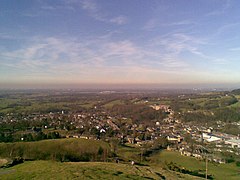Bollington
| Bollington | |
|---|---|
 A view over Bollington from White Nancy, looking north |
|
| Bollington shown within Cheshire | |
| Population | 8,310 (2011) |
| OS grid reference | SJ9377 |
| Civil parish |
|
| Unitary authority | |
| Ceremonial county | |
| Region | |
| Country | England |
| Sovereign state | United Kingdom |
| Post town | MACCLESFIELD |
| Postcode district | SK10 |
| Dialling code | 01625 |
| Police | Cheshire |
| Fire | Cheshire |
| Ambulance | North West |
| EU Parliament | North West England |
| UK Parliament | |
Bollington is a small town and civil parish in Cheshire, England, to the east of Prestbury. In the Middle Ages it was part of the Earl of Chester's manor of Macclesfield, and the ancient parish of Prestbury. In 2001, Bollington had a population of 7,095. (8,310 in 2011 census)
Bollington, locally nicknamed "Happy Valley", is on the River Dean and the Macclesfield Canal, on the south-western edge of the Peak District. Rising above the town is Kerridge Hill that is surmounted by White Nancy, a monument built to commemorate the Battle of Waterloo in the Napoleonic Wars.
Bollington is twinned with Thurles in County Tipperary, Ireland.
In the 19th and 20th centuries, Bollington was a major centre for cotton spinning. The Waterhouse Mill, now demolished, off Wellington Road, once spun the finest cotton in the world, and was sought after by lace makers in Nottingham and Brussels.
Clarence Mill still stands and has since been converted into luxury apartments. One of the oldest surviving mills in Bollington is the very small Defiance Mill, built in Queen Street about 1800 and also now restored for residential occupation.
There is a large paper coating mill on the site of Lower Mills. The original mill was built by George Antrobus in 1792 but very little of those buildings remain. A stone-built traditional mill still survives amongst the more recent brick developments. In the 1830s and 1840s this mill was rented to Thomas Oliver and Martin Swindells for the production of fine cotton thread for the lace-making industry.
Other remaining mills include Adelphi (Swindells, 1856) and Lowerhouse (Antrobus, 1819, later occupied by Samuel Greg Jnr).
...
Wikipedia

